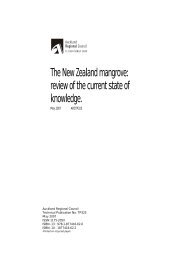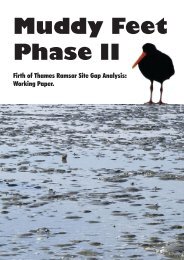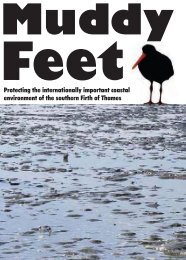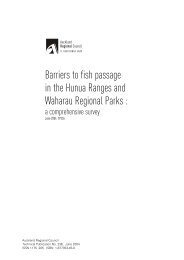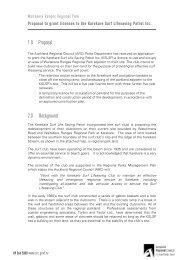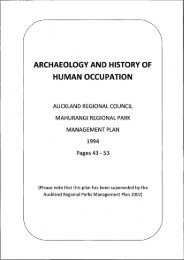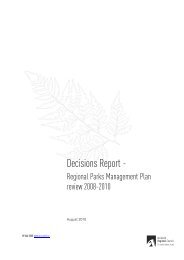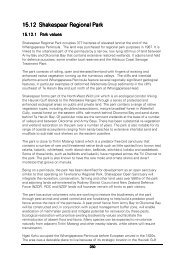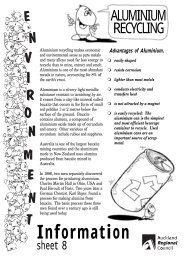- Page 1 and 2: MUDDY FEET FIRTH OF THAMES RAMSAR S
- Page 3 and 4: MUDDY FEET FIRTH OF THAMES RAMSAR S
- Page 5 and 6: Contents List of Figures List of Ta
- Page 7 and 8: 11.7 Current Research in the Firth
- Page 9 and 10: List of Tables Table 5-1 Comparativ
- Page 11 and 12: Acknowledgements This report was ma
- Page 13 and 14: Preface Muddy feet. All resident an
- Page 15 and 16: 1 Introduction by Ria Brejaart and
- Page 17 and 18: Figure 1-1 Southern Hauraki Gulf an
- Page 19 and 20: Wind and tidal currents cause a net
- Page 21 and 22: Figure 1-4 continued. EcoQuest Educ
- Page 23 and 24: studies, some of which use the Chen
- Page 25 and 26: providing for the drainage and sett
- Page 27 and 28: 2 Hydrology by Ria Brejaart, Bill B
- Page 29 and 30: 2.2 Summary of Cheatley (2000) Grou
- Page 31 and 32: 3 Vegetation by Peter Maddison and
- Page 33 and 34: mangroves positioned between the ma
- Page 35 and 36: and available habitat types for wad
- Page 37: Family Asteraceae *Aster subulatus
- Page 41 and 42: Future Work: Spartina is a recognis
- Page 43 and 44: *Trifolium glomeratum - clustered c
- Page 45 and 46: 4 Terrestrial Invertebrates & Mamma
- Page 47 and 48: Heteronychus arator (Fabricius) - B
- Page 49 and 50: The extensive mangrove community th
- Page 51 and 52: establishing in areas where tempera
- Page 53 and 54: It appears from our observations an
- Page 55 and 56: 41 Figure -5-1 June, 1963 aerial ph
- Page 57 and 58: 43 Figure -5-3: Waitakaruru River t
- Page 59 and 60: 45 1 Upstream view about 100m from
- Page 61 and 62: 47 Looking west: 1 Dredge spoils af
- Page 63 and 64: 49 5.6 Revegetation of the Spoils A
- Page 65 and 66: 51 The five field investigations of
- Page 67 and 68: 53 issue of proper disposal, whethe
- Page 69 and 70: 55 Figure 6-1 Important Sites for w
- Page 71 and 72: 57 Figure 6-3 Changing habitats at
- Page 73 and 74: 59 • Over 1983-1994, rarer waders
- Page 75 and 76: 61 Thames, knots have been recorded
- Page 77 and 78: 63 stop-peck’. On pasture they fe
- Page 79 and 80: 65 6.5 Other Wader Species As in ot
- Page 81 and 82: 67 graze on grass and other low-gro
- Page 83 and 84: 69 Little black shag - Phalacrocora
- Page 85 and 86: 71 6.8 Terrestrial Species A few of
- Page 87 and 88: 73 Figure 6-4 Wader watchers: a com
- Page 89 and 90:
75 S. I. pied oystercatcher Torea H
- Page 91 and 92:
77 7 Estuarine Fish, Fisheries and
- Page 93 and 94:
79 firmer patches of bottom near th
- Page 95 and 96:
81 (between Kaiaua and Orere Point)
- Page 97 and 98:
83 large quantities of unwanted har
- Page 99 and 100:
85 Only four or five of the small b
- Page 101 and 102:
87 stage in the sea. These species
- Page 103 and 104:
89 Appendix 7.1 Fishes of the South
- Page 105 and 106:
91 8 Benthic Ecology Part 1 - A pre
- Page 107 and 108:
93 at a size that would have allowe
- Page 109 and 110:
95 8.3.2 Across-shore trends Simila
- Page 111 and 112:
97 Relative abundances m 2 30 25 20
- Page 113 and 114:
99 from fine silts to sandy mud in
- Page 115 and 116:
101 cumulative downstream effects f
- Page 117 and 118:
103 8.7 Study site Sampling took pl
- Page 119 and 120:
105 Table 8-8 Total for organisms c
- Page 121 and 122:
107 should be mapped :physical and
- Page 123 and 124:
109 including scenery, ecological s
- Page 125 and 126:
111 Important resource management a
- Page 127 and 128:
113 • Relevant provisions of the
- Page 129 and 130:
115 Figure 9-1 Zoning map of Thames
- Page 131 and 132:
117 Figure 9-2 Zoning map of Kaiaua
- Page 133 and 134:
119 The decision to impose a tapu i
- Page 135 and 136:
121 9.9 Discussion The coast road t
- Page 137 and 138:
123 10 Raising Conservation Awarene
- Page 139 and 140:
125 10.2.4 Waikato Conservancy In 2
- Page 141 and 142:
127 • Is there a need for more ef
- Page 143 and 144:
129 The Kaiaua Citizens’ and Rate
- Page 145 and 146:
131 • What are the causes of the
- Page 147 and 148:
133 • Formation of a better pictu
- Page 149 and 150:
135 11.4.2 Marine farming Mussels a
- Page 151 and 152:
137 Five permanent sites in the upp
- Page 153 and 154:
139 • Uptake of nutrients by muss
- Page 155 and 156:
141 12 Firth of Thames Ramsar Site
- Page 157 and 158:
143 regard to substrates that norma
- Page 159 and 160:
145 The construction of the stop ba
- Page 161 and 162:
147 Physical (toxic chemicals, nutr
- Page 163 and 164:
149 The jurisdictional boundary (be
- Page 165 and 166:
151 What are the preferred food spe
- Page 167 and 168:
153 How to attract a “manageable
- Page 169 and 170:
155 Local involvement It was noted
- Page 171 and 172:
157 Sedimentation: particle size di
- Page 173 and 174:
159 Melville David Ornithological S
- Page 175 and 176:
161 Firth toward a few species that
- Page 177 and 178:
163 A clear, consistent definition
- Page 179 and 180:
165 14 Bibliography By Marie Buchle
- Page 181 and 182:
167 Keywords: Waihou and tributarie
- Page 183 and 184:
169 Copy held and available from th
- Page 185 and 186:
171 Subject: Vegetation Keywords: L
- Page 187 and 188:
173 Subject: Birds, mangroves Cox,
- Page 189 and 190:
175 de Lange, P.J., & Lowe, D.J. (1
- Page 191 and 192:
177 Estcourt, I.N. (1976). Bibliogr
- Page 193 and 194:
179 Subject: Fish Keywords: new gob
- Page 195 and 196:
181 Harris, R.W. (1975). Summary of
- Page 197 and 198:
183 Jillett, J.B. (1966). Plankton
- Page 199 and 200:
185 landform which holds valuable i
- Page 201 and 202:
187 Copy held: EQ McKenzie, H.R. (1
- Page 203 and 204:
189 mixed terrigenous-carbonate gra
- Page 205 and 206:
191 accounts for water movement at
- Page 207 and 208:
193 Pierce, R. J. (1999). Regional
- Page 209 and 210:
195 Subject: Benthic ecology Keywor
- Page 211 and 212:
197 Subject: Birds. Record of occas
- Page 213 and 214:
199 Keywords: dredge disturbance, b
- Page 215 and 216:
201 Keywords: environmental managem
- Page 217:
203 Zharikov, Y. & Skilleter, G.A.



